Forecast of Changes in Air Temperatures and Heat Indices in the Sevastopol Region in the 21st Century and Their Impacts on Viticulture
Abstract
1. Introduction
2. Materials and Methods
- -
- The mean annual air temperature;
- -
- -
- The Huglin heliothermal index is used to define the suitability of cultivars for the region and to classify wine-making regions [32]. The index is calculated on the basis of such factors as the mean duration of daylight and biologically effective temperatures for 1 April–30 September in the Northern hemisphere [31];
- -
- -
- The sum of active air temperatures above 10 °C.
3. Results
4. Discussion and Conclusions
Author Contributions
Funding
Data Availability Statement
Acknowledgments
Conflicts of Interest
References
- Van Leeuwen, C.; Friant, P.; Xavier, C.; Tregoat, O.; Koundouras, S.; Dubourdieu, D. Influence of climate, soil, and cultivar on terroir. Am. J. Enol. Vitic. 2004, 55, 207–217. [Google Scholar]
- Santos, J.A.; Fraga, H.; Malheiro, A.C.; Moutinho-Pereira, J.; Dinis, L.-T.; Correia, C.; Moriondo, M.; Leolini, L.; Dibari, C.; Costafreda-Aumedes, S.; et al. A Review of the Potential Climate Change Impacts and Adaptation Options for European Viticulture. Appl. Sci. 2020, 10, 3092. [Google Scholar] [CrossRef]
- Schultz, H.R. Climate change and viticulture: A European perspective on climatology, carbon dioxide and UV-B effects. Aust. J. Grape Wine Res. 2000, 6, 2–12. [Google Scholar] [CrossRef]
- Jones, G.V.; White, M.A.; Cooper, O.R.; Storchmann, K. Climate change and global wine quality. Clim. Chang. 2005, 73, 319–343. [Google Scholar] [CrossRef]
- De Orduña, R.M. Climate change associated effects on grape and wine quality and production. Food Res. Int. 2010, 43, 1844–1855. [Google Scholar] [CrossRef]
- Ashenfelter, O. Predicting the quality and prices of bordeaux wine. World Sci. Handb. Financ. Econ. Ser. 2018. [Google Scholar] [CrossRef]
- IPCC. Climate Change 2014: Synthesis Report; Contribution of Working Groups I, II and III to the Fifth Assessment Report of the Intergovernmental Panel on Climate Change; Core Writing Team, Pachauri, R.K., Meyer, L.A., Eds.; IPCC: Geneva, Switzerland, 2014; 151p. [Google Scholar]
- Fraga, H.; Garcia de Cortazar-Atauri, I.; Malheiro, A.C.; Santos, J.A. Modelling climate change impacts on viticultural yield, phenology and stress conditions in Europe. Glob. Chang. Biol. 2016, 22, 3774–3788. [Google Scholar] [CrossRef] [PubMed]
- Webb, L.B.; Watterson, I.; Bhend, J.; Whetton, P.H.; Barlow, E.W.R. Global climate analogues for winegrowing regions in future periods: Projections of temperature and precipitation. Aust. J. Grape Wine Res. 2013, 19, 331–341. [Google Scholar] [CrossRef]
- Hannah, L.; Roehrdanz, P.R.; Ikegami, M.; Shepard, A.V.; Shaw, M.R.; Tabor, G.; Zhi, L.; Marquet, P.A.; Hijmans, R.J. Climate change, wine, and conservation. Proc. Natl. Acad. Sci. USA 2013, 110, 6907–6912. [Google Scholar] [CrossRef]
- Santillán, D.; Garrote, L.; Iglesias, A.; Sotes, V. Climate change risks and adaptation: New indicators for Mediterranean viticulture. Mitig. Adapt. Strateg. Glob. Chang. 2020, 25, 881–899. [Google Scholar] [CrossRef]
- Cardell, M.F.; Amengual, A.; Romero, R. Future effects of climate change on the suitability of wine grape production across Europe. Reg. Environ. Chang. 2019, 19, 2299–2310. [Google Scholar] [CrossRef]
- Neethling, E.; Petitjean, T.; Quénol, H.; Barbeau, G. Assessing local climate vulnerability and winegrowers’ adaptive processes in the context of climate change. Mitig. Adapt. Strat. Glob. Chang. 2017, 22, 777–803. [Google Scholar] [CrossRef]
- Fraga, H.; García de Cortázar Atauri, I.; Santos, J.A. Viticultural irrigation demands under climate change scenarios in Portugal. Agric. Water Manag. 2018, 196, 66–74. [Google Scholar] [CrossRef]
- Koufos, G.; Mavromatis, T.; Koundouras, S.; Jones, G.V. Response of viticulture-related climatic indices and zoning to historical and future climate conditions in Greece. Int. J. Climatol. 2017, 38, 2097–2111. [Google Scholar] [CrossRef]
- Koufos, G.C.; Mavromatis, T.; Koundouras, S.; Jones, G.V. Adaptive capacity of winegrape varieties cultivated in Greece to climate change: Current trends and future projections. OENO One 2020, 4, 1201–1219. [Google Scholar] [CrossRef]
- Omazi, B.; Prtenjak, M.T.; Prša, I.; Vozila, A.B.; Vućetić, V.; Karoglan, M.; Kontić, J.K.; Prša, Ž.; Anić, M.; Šimon, S.; et al. Climate change impacts on viticulture in Croatia: Viticultural zoning and future potential. Int. J. Climatol. 2020, 1–22. [Google Scholar] [CrossRef]
- Eitzinger, J.; Kubu, G.; Formayer, H.; Gerersdorfer, T. Climatic wine growing potential under future climate scenarious in Austria. In Sustainable Development and Bioclimate: Reviewed Conference Proceedings; Slovak Acad Sciences: Bratislava, Slovakia, 2009; pp. 146–147. [Google Scholar]
- Malheiro, A.C.; Santos, J.A.; Fraga, H.; Pinto, J.G. Climate change scenarios applied to viticultural zoning in Europe. Clim. Res. 2010, 43, 163–177. [Google Scholar] [CrossRef]
- Gaál, M.; Moriondo, M.; Bindi, M. Modelling the impact of climate change on the Hungarian wine regions using Random Forest. Appl. Ecol. Environ. Res. 2012, 10, 121–140. [Google Scholar] [CrossRef]
- Tóth, J.P.; Végvári, Z. Future of winegrape growing regions in Europe. Aust. J. Grape Wine Res. 2016, 22, 64–72. [Google Scholar] [CrossRef]
- Machar, I.; Vlčková, V.; Buček, A.; Vrublová, K.; Filippovová, J.; Brus, J. Environmental Modelling of Climate Change Impact on Grapevines: Case Study from the Czech Republic. Pol. J. Environ. Stud. Vol. 2017, 26, 1927–1934. [Google Scholar] [CrossRef]
- Trbic, G.; Djurdjevic, V.I.; Mandic, M.V.; Ivanisevic, M.; Cupac, R.; Bajic, D.; Zahirovic, E.; Filipovic, D.; Dekic, R.; Popov, T.; et al. The impact of climate change on grapevines in Bosnia and Herzegovina. Euro-Mediterr. J. Environ. Integr. 2021, 6, 4. [Google Scholar] [CrossRef]
- Mendoza, G.H.; Ramos, C.A.G.; Corral, D.M.H.; Cruz, R.S.; Garbolino, E. Assessing Suitable Areas of Common Grapevine (Vitis vinifera L.) for Current and Future Climate Situations: The CDS Toolbox SDM. Atmosphere 2020, 11, 1201. [Google Scholar] [CrossRef]
- Hewer, M.J.; Brunette, M. Climate change impact assessment on grape and wine for Ontario, Canada’s appellations of origin. Reg. Environ. Chang. 2020, 20, 86. [Google Scholar] [CrossRef]
- Hewer, M.J.; Gough, W.A. Assessing the impact of projected climate change on the future of grape growth and wine production in the Niagara Peninsula (Canada). J. Wine Res. 2020, 34, 6–34. [Google Scholar] [CrossRef]
- Cabré, F.; Nuñez, M. Impacts of climate change on viticulture in Argentina. Reg. Environ. Chang. 2020, 20, 12. [Google Scholar] [CrossRef]
- Vyshkvarkova, E.V.; Rybalko, E.A.; Baranova, N.V.; Voskresenskaya, E.N. Favorability Level Analysis of the Sevastopol Region’s Climate for Viticulture. Agronomy 2020, 10, 1226. [Google Scholar] [CrossRef]
- Socioeconomic Development Strategy of the City of Sevastopol; Legislative Assembly of the City of Sevastopol: Sevastopol, Russia, 2017; 171p.
- Intergovernmental Panel on Climate Change (IPCC). Good Practice Guidance Paper on Assessing and Combining Multi Model Climate Projections; National Center for Atmospheric Research: Boulder, CO, USA, 2010. [Google Scholar]
- Shaw, T.B. Climate change and the evolution of the Ontario cool climate wine regions in Canada. J. Wine Res. 2016. [Google Scholar] [CrossRef]
- Huglin, P. Nouveau mode d’évaluation des possibilities héliothermiques d’un milieu viticole. In Proceedings of the Symposium International sur l’Ecologie de la Vigne, Constanta, Romania, 25–29 September 1978; Ministère de l’Agriculture et de l’Industrie Alimentaire: Constanta, Romania, 1978; pp. 89–98. [Google Scholar]
- Amerine, M.A.; Winkler, A.J. Composition and quality of musts and wines of California grapes. Hilgardia 1944, 15, 493–675. [Google Scholar] [CrossRef]
- Winkler, A.J.; Cook, J.A.; Kliwer, W.M.; Lider, L.A. General Viticulture; University of California Press: Berkeley, CA, USA, 1974. [Google Scholar]
- Rybalko, E.A. Adaptation of the mathematical model of the spatial distribution of heat supply in the territory in order to efficiently place industrial vineyards on the territory of the Crimean Peninsula. Vinograd. Vinodel. 2014, 2, 10–11. [Google Scholar]
- Gladstones, J. Wine, Terroir and Climate Change; Wakefield Press: Mile End, Australia, 2011; 279p. [Google Scholar]
- Poni, S.; Gatti, M.; Palliotti, A.; Dai, Z.; Duchêne, E.; Truong, T.-T.; Ferrara, G.; Matarrese, A.M.S.; Gallotta, A.; Bellincontro, A.; et al. Grapevine quality: A multiple choice issue. Sci. Hortic. 2018, 234, 445–462. [Google Scholar] [CrossRef]
- Venios, X.; Korkas, E.; Nisiotou, A.; Banilas, G. Grapevine Responses to Heat Stress and Global Warming. Plants 2020, 9, 1754. [Google Scholar] [CrossRef] [PubMed]
- Schultz, H.R.; Jones, G.V. Climate induced historic and future changes in viticulture. J. Wine Res. 2010, 21, 137–145. [Google Scholar] [CrossRef]
- Novikova, L.Y.; Naumova, L.G. Dependence of Fresh Grapes and Wine Taste Scores on the Origin of Varieties and Weather Conditions of the Harvest Year in the Northern Zone of Industrial Viticulture in Russia. Agronomy 2020, 10, 1613. [Google Scholar] [CrossRef]
- Jones, G.V. Climate and terroir: Impacts of climate variability and change on wine. In Fine Wine and Terroir—The Geoscience Perspective; Meinert, L.D., Ed.; Geoscience Canada, Geological Association of Canada: St. John’s, NL, Canada, 2006; pp. 1–14. [Google Scholar]
- Nesbitt, A.; Kemp, B.; Steele, C.; Lovett, A.; Dorling, S. Impact of recent climate change and weather variability on the viability of UK viticulture–combining weather and climate records with producers’ perspectives. Aust. J. Grape Wine Res. 2016, 22, 324–335. [Google Scholar] [CrossRef]
- Davitaya, F.F. Basic Principles of Zoning of Grape Culture//Physiology of Grapes and the Basics of Its Cultivation; Bulgaria Academy Sofia: Sofia, Bulgaria, 1981; pp. 27–52. [Google Scholar]
- Tonietto, J.; Carbonneau, A.A. Multicriteria climatic classification system for grape growing regions worldwide. Agric. For. Meteorol. 2004, 124, 81–97. [Google Scholar] [CrossRef]
- Keller, M. The Science of Grapevines: Anatomy and Physiology; Elsevier, Inc.: New York, NY, USA, 2010; p. 400. [Google Scholar]
- Biasi, R.; Brunori, E.; Ferrara, C.; Salvati, L. Assessing impacts of climate change on phenology and quality traits on Vitis vinifera, L.: The contribution of local knowledge. Plants 2019, 8, 121. [Google Scholar] [CrossRef]
- Molitor, D.; Junk, J.; Evers, D.; Hoffmann, L.; Beyer, M. A high-resolution cumulative degree day-based model to simulate phenological development of grapevine. Am. J. Enol. Vitic. 2014, 65, 72–80. [Google Scholar] [CrossRef]
- Fraga, H.; Santos, J.A.; Malheiro, A.C.; Oliveira, A.A.; Moutinho-Pereira, J.; Joness, G.V. Climatic suitability of Portuguese grapevine varieties and climate change adaptation. Int. J. Climatol. 2015, 36, 1–12. [Google Scholar] [CrossRef]
- Pina-Rey, A.; Gonzalez-Fernandez, E.; Fernandez-Gonzalez, M.; Lorenzo, M.N.; Rodriguez-Rajo, F.J. Climate Change impacts assessment on wine-growing bioclimatic transition areas. Agriculture 2020, 10, 605. [Google Scholar] [CrossRef]
- Nesbit, A.; Dorling, S.; Lovett, A. A suitability model for viticulture in England and Wales: Opportunities for investment, sector growth and increased climate resilience. J. Land Use Sci. 2018, 13, 414–438. [Google Scholar] [CrossRef]
- Petrov, V.S.; Aleynikova, G.Y.; Novikova, L.Y.; Naumova, L.G.; Lukyanova, A.A. The influence of climate changes on the grape phenology. Fruit Grow. Vitic. South Russ. 2019, 57, 29–50. [Google Scholar] [CrossRef]
- Caffarra, A.; Eccel, E. Projecting the impacts of climate change on the phenology of grapevine in a mountain area. Aust. J. Grape Wine Res. 2011, 17, 52–61. [Google Scholar] [CrossRef]
- Moriondo, M.; Jones, G.V.; Bois, B.; Dibari, C.; Ferrise, R.; Trombi, G.; Bindi, M. Projected shifts of wine regions in response of climate change. Clim. Chang. 2013, 119, 825–839. [Google Scholar] [CrossRef]
- Ponti, L.; Gutierrez, A.P.; Boggia, A.; Neteler, M. Analysis of grape production in the face of climate change. Climate 2018, 6, 20. [Google Scholar] [CrossRef]
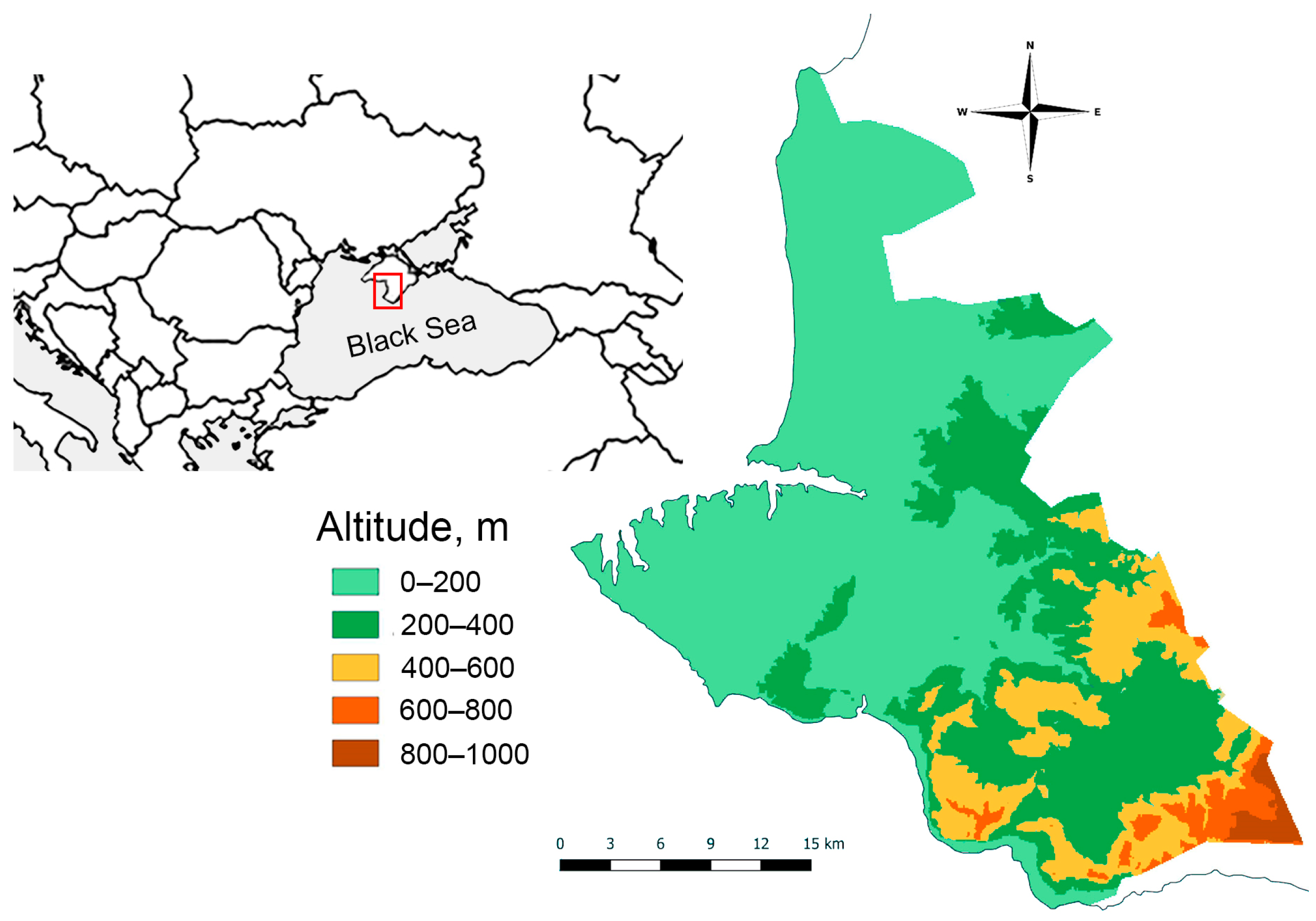
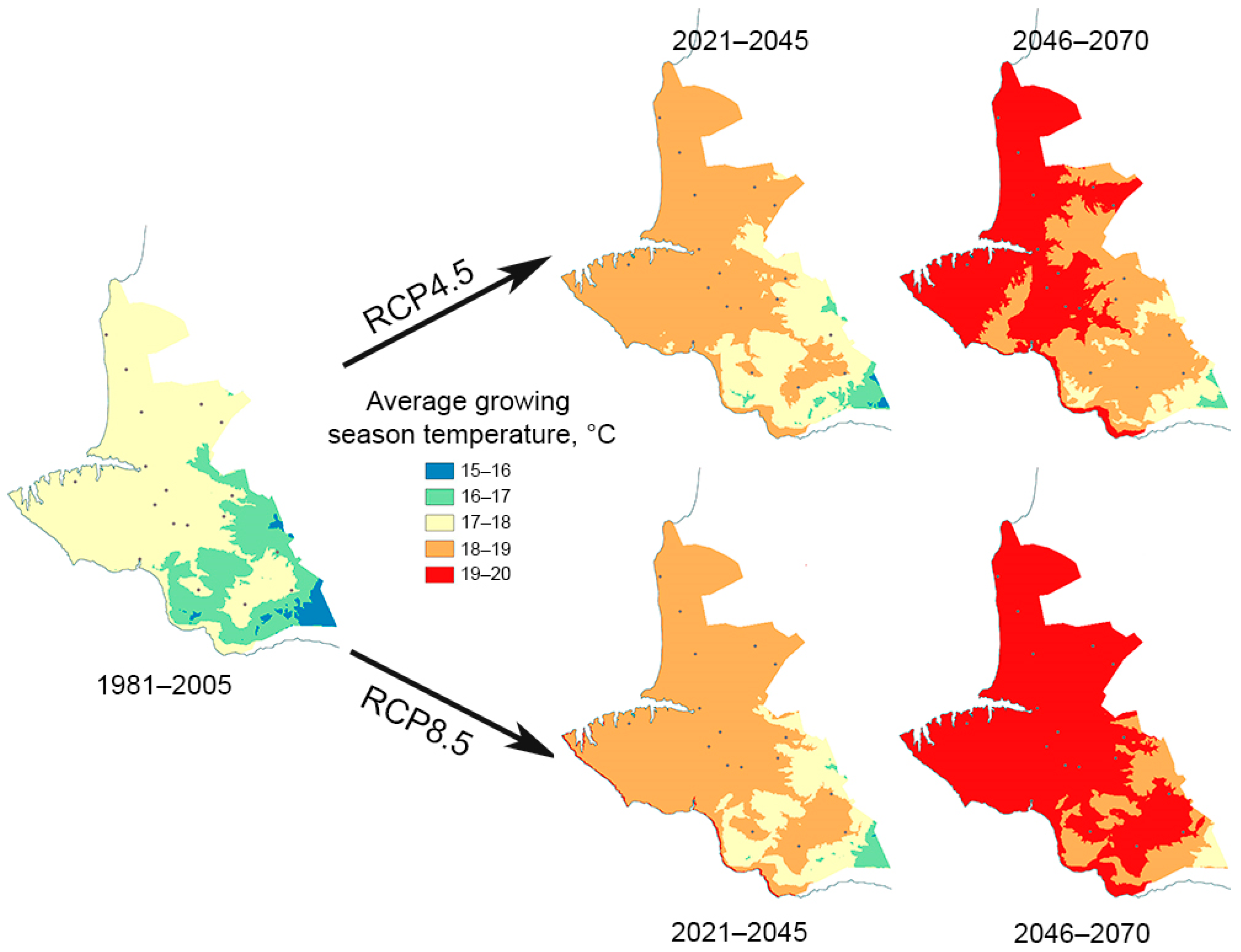
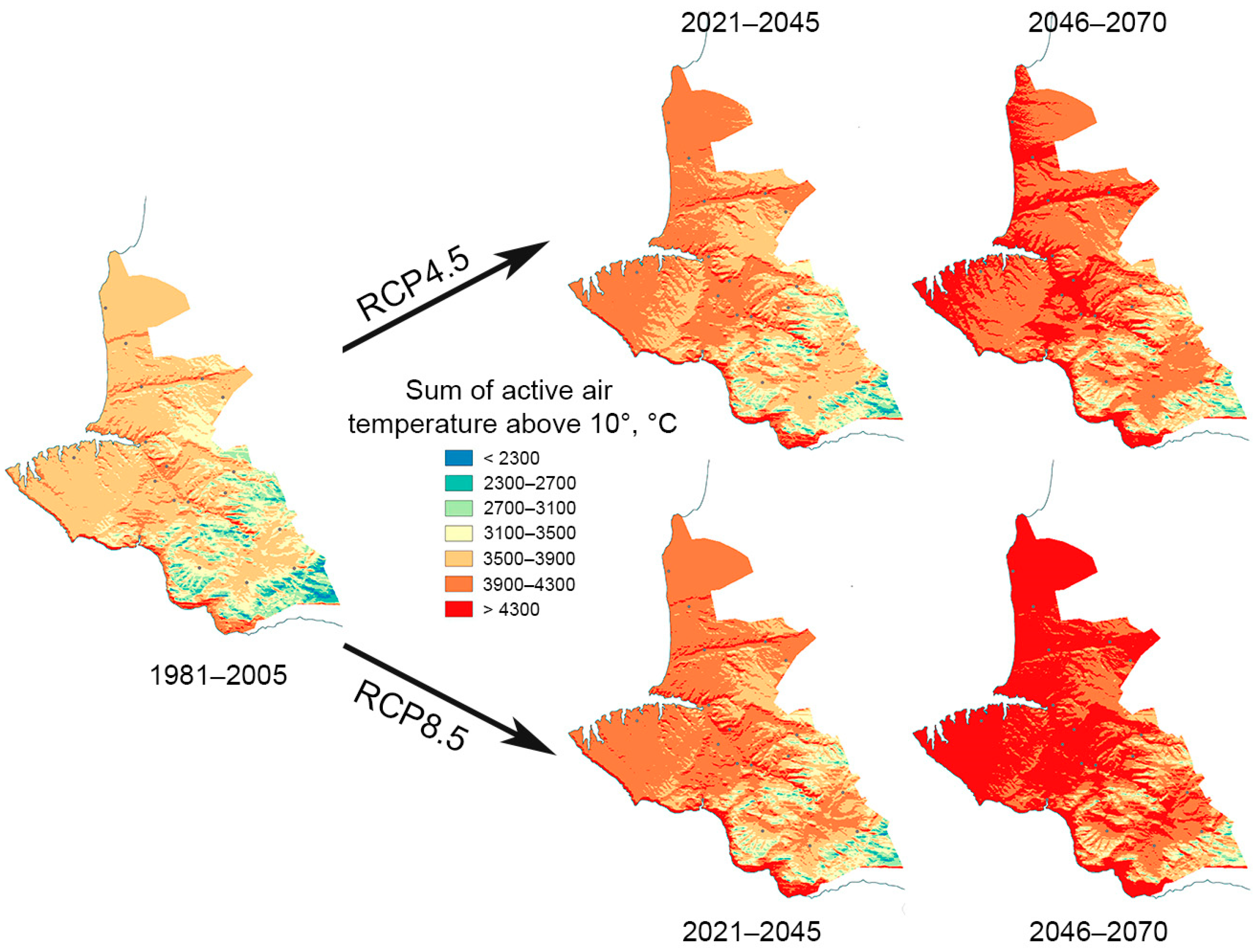
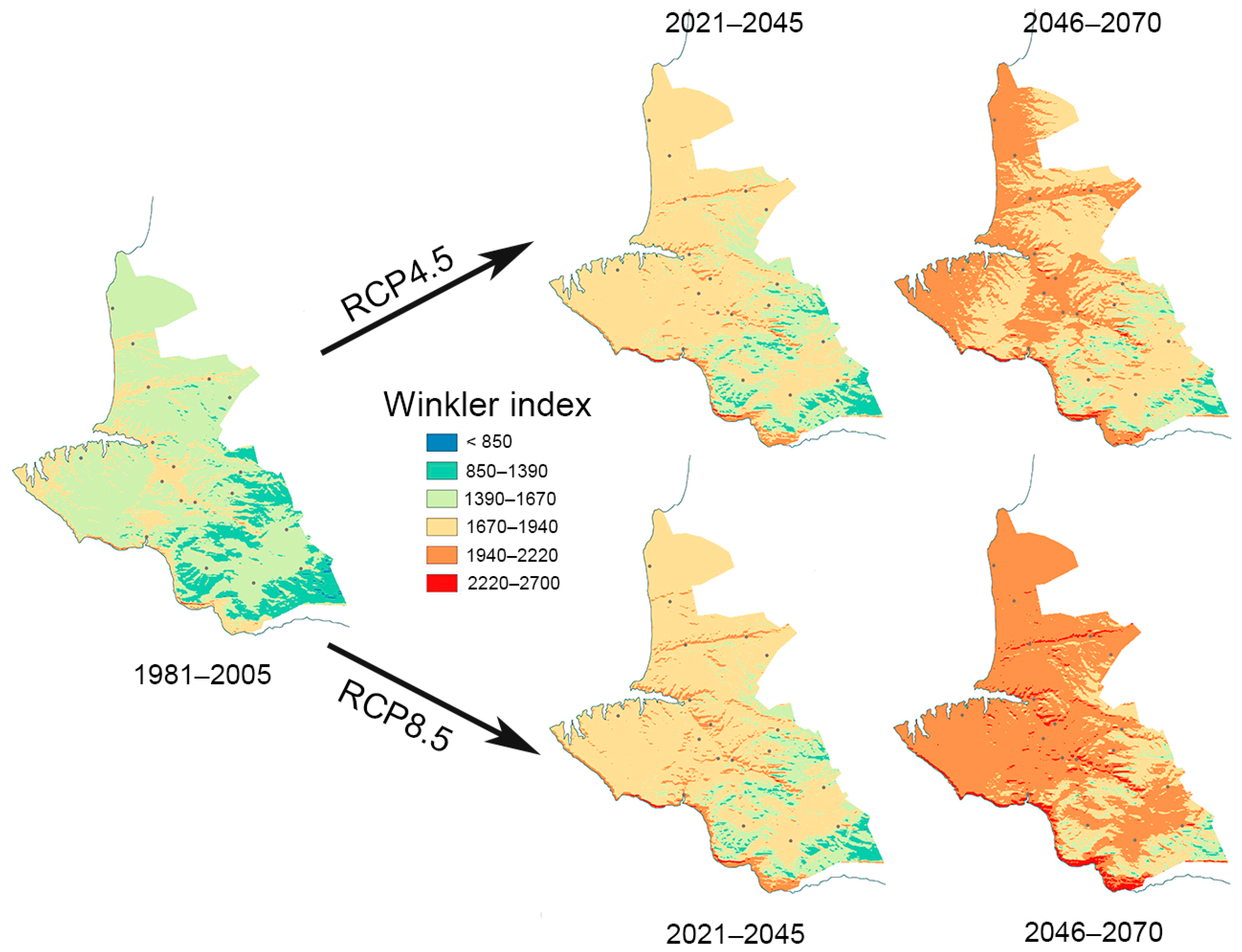
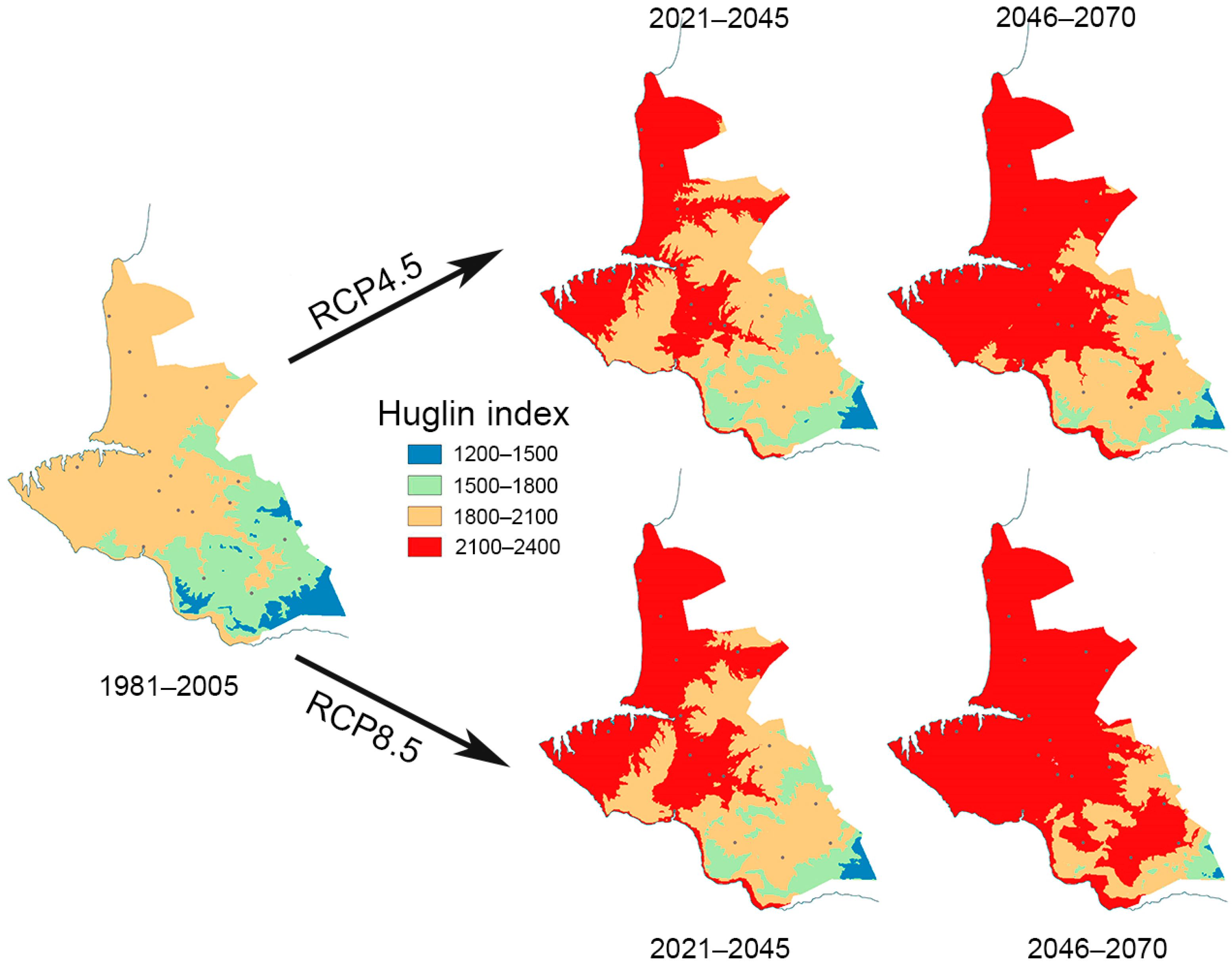
| Driving GCM | RCM |
|---|---|
| ICHEC-EC-EARTH | KNMI-RACMO22E |
| MPI-M-MPI-ESM-LR | MPI-CSC-REMO2009 |
| CLMcom-CCLM4-8-17 | |
| CNRM-CERFACS-CNRM-CM5 | CNRM-ALADIN53 |
| CLMcom-CCLM4-8-17 | |
| SMHI-RCA4 | |
| IPSL-IPSL-CM5A-MR | IPSL-INERIS-WRF331F |
| SMHI-RCA4 |
| Sum of Effective Temperature (°C) | Base Period (1981–2005) | Future Period 1 (2021–2045) | Future Period 2 (2046–2070) | ||
|---|---|---|---|---|---|
| RCP4.5 | RCP8.5 | RCP4.5 | RCP8.5 | ||
| <2300 | 0.7 | 0.2 | 0.1 | 0.0 | 0.0 |
| 2300–2700 | 2.5 | 1.1 | 0.7 | 0.3 | 0.1 |
| 2700–3100 | 7.6 | 3.8 | 2.8 | 1.8 | 0.8 |
| 3100–3500 | 18.8 | 10.1 | 8.3 | 5.7 | 3.0 |
| 3500–3900 | 59.3 | 32.2 | 21.7 | 13.0 | 8.7 |
| 3900–4300 | 9.8 | 48.3 | 58.3 | 50.9 | 24.5 |
| >4300 | 1.2 | 4.4 | 8.1 | 28.3 | 62.9 |
| WI Classes | Base Period (1981–2005) | Future Period 1 (2021–2045) | Future Period 2 (2046–2070) | ||
|---|---|---|---|---|---|
| RCP4.5 | RCP8.5 | RCP4.5 | RCP8.5 | ||
| <850 Too cool | 0.2 | 0.0 | 0.0 | 0.0 | 0.0 |
| 850–1390 Region 1 | 15.3 | 5.1 | 3.8 | 1.8 | 0.4 |
| 1390–1670 Region 2 | 67.1 | 20.4 | 16.0 | 10.3 | 4.5 |
| 1670–1940 Region 3 | 16.9 | 70.3 | 72.7 | 48.2 | 18.3 |
| 1940–2220 Region 4 | 0.4 | 3.9 | 7.2 | 38.7 | 72.4 |
| 2220–2700 Region 5 | 0.0 | 0.2 | 0.3 | 1.1 | 4.4 |
| HI Classes | Base Period (1981–2005) | Future Period 1 (2021–2045) | Future Period 2 (2046–2070) | ||
|---|---|---|---|---|---|
| RCP4.5 | RCP8.5 | RCP4.5 | RCP8.5 | ||
| 1200–1500 Very cool | 6.3 | 1.6 | 1.4 | 0.8 | 0.2 |
| 1500–1800 Cool | 27.9 | 12.0 | 9.9 | 5.8 | 2.2 |
| 1800–2100 Temperate | 65.8 | 47.3 | 40.3 | 28.8 | 15.9 |
| 2100–2400 Warm temperate | 0.0 | 39.0 | 48.4 | 64.6 | 81.7 |
Publisher’s Note: MDPI stays neutral with regard to jurisdictional claims in published maps and institutional affiliations. |
© 2021 by the authors. Licensee MDPI, Basel, Switzerland. This article is an open access article distributed under the terms and conditions of the Creative Commons Attribution (CC BY) license (https://creativecommons.org/licenses/by/4.0/).
Share and Cite
Vyshkvarkova, E.; Rybalko, E. Forecast of Changes in Air Temperatures and Heat Indices in the Sevastopol Region in the 21st Century and Their Impacts on Viticulture. Agronomy 2021, 11, 954. https://doi.org/10.3390/agronomy11050954
Vyshkvarkova E, Rybalko E. Forecast of Changes in Air Temperatures and Heat Indices in the Sevastopol Region in the 21st Century and Their Impacts on Viticulture. Agronomy. 2021; 11(5):954. https://doi.org/10.3390/agronomy11050954
Chicago/Turabian StyleVyshkvarkova, Elena, and Evgeniy Rybalko. 2021. "Forecast of Changes in Air Temperatures and Heat Indices in the Sevastopol Region in the 21st Century and Their Impacts on Viticulture" Agronomy 11, no. 5: 954. https://doi.org/10.3390/agronomy11050954
APA StyleVyshkvarkova, E., & Rybalko, E. (2021). Forecast of Changes in Air Temperatures and Heat Indices in the Sevastopol Region in the 21st Century and Their Impacts on Viticulture. Agronomy, 11(5), 954. https://doi.org/10.3390/agronomy11050954







